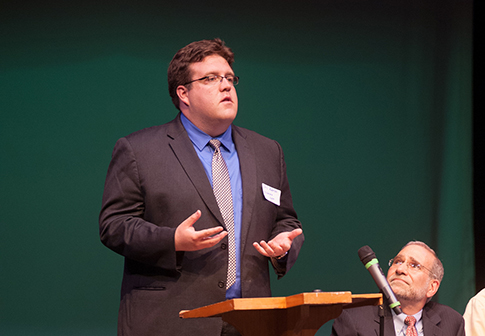
Chris Anderson, Watershed Partnerships Coordinator with Philadelphia Water, talks about what the Clean Water Rule means for our source water at a June 17 forum. Credit: TTF Watershed Partnership.
If you pay attention to news about environmental issues, you’ve likely heard buzz around something called the Clean Water Rule lately.
The Clean Water Rule, officially adopted at the end of May and formalized by President Obama, clarifies what waterways fall under the protection of the federal Clean Water Act and came as result of an extensive public input process organized by the U.S. Environmental Protection Agency (EPA) and the U.S. Army Corps of Engineers.
On May 27, the EPA released a statement(Sorry, this content is no longer available) explaining why the Clean Water Rule is needed:
Protection for many of the nation’s streams and wetlands has been confusing, complex, and time-consuming as the result of Supreme Court decisions in 2001 and 2006. EPA and the Army [Corps] are taking this action today to provide clarity on protections under the Clean Water Act after receiving requests for over a decade from members of Congress, state and local officials, industry, agriculture, environmental groups, scientists, and the public for a rulemaking.
So, what does all this mean for Philadelphia Water and the local rivers and creeks that provide our drinking water?
The short answer is that the Clean Water Rule doesn’t change anything about how we do things at Philadelphia Water or impact how waterways are regulated and protected in the city. However, it does strengthen protections for the sources of our drinking water by clearing up any confusion about how the Clean Water Act applies to the wetlands and tributaries that feed the Delaware and Schuylkill rivers.
That’s extremely important, says Kelly Anderson, a member of our Source Water Protection Program, because 98 percent of the watershed area that influences Philadelphia’s drinking water supply is outside of the city’s regulatory jurisdiction.
Because having clear protections for that source water means healthier rivers downstream in Philadelphia, we have publicly endorsed the rule and expressed our support to local elected officials.
Philadelphia Water Commissioner Howard Neukrug advocated for the Clean Water Rule by expressing the department’s support to groups like Clean Water Action and by sending letters to elected officials at the state and federal level.
“This clarifying rulemaking restores protection for streams and wetlands previously protected under the Clean Water Act, safeguards water quality in the nation’s waters, protects jobs in businesses that depend on clean water and safeguards drinking water,” Neukrug said.
Just last week, Philadelphia Water took part in a forum on the Clean Water Rule with fellow watershed stewards like the Tookany/Tacony Frankford Watershed Partnership.
At that event, Philadelphia Water’s Chris Anderson explained how the rule gives clarity to the many partners in our Source Water Protection Program, which works to make sure our drinking water sources—which range from the Catskill Mountains of New York to the Delaware Estuary to the south—are protected from pollution.
Philadelphia Water also came out in support of the Clean Water Rule at a June 1 event at the Fairmount Water Works organized by PennEnvironment to educate the public about what the rule means for Pennsylvanians.
Christine Knapp, deputy chief of staff for Philadelphia Water, touted recent water quality improvements at the event, but said the Clean Water Rule is an important part of making sure we keep moving forward.
“Philadelphia Water can only control what happens in the city, not what happens upstream. In addition to stormwater runoff, additional threats such as agricultural runoff, pollution from wildlife, and forest clearing all take place upstream from Philadelphia, and yet have negative impacts on Philadelphia’s water supply,” Knapp said at the event. “That’s why the Clean Water Rule is so critical. By providing protection for additional streams and wetlands, it will leverage investments being made by Philadelphia Water—and municipalities all around the country—to prevent pollution and to improve the quality of our drinking water. We applaud this rulemaking by the EPA and the Army Corps and look forward to working with them and other regional stakeholders in our mission to protect public health by providing the highest quality drinking water.”
The Clean Water Rule By The Numbers:
98 Percent: The watershed area that influences Philadelphia’s drinking water supply, but is outside of the city’s regulatory jurisdiction.
117 Million: The number of people getting drinking water from streams that lacked clear protection before the Clean Water Rule, according to EPA estimates. That’s one in three Americans.
1 Million: The number of public comments the EPA reviewed as a result of public input efforts leading up to the development of the rule.
400: EPA and Army Corps meetings held with drinking water stakeholders across the country.
1,200: Peer-reviewed, published scientific studies showing that small streams and wetlands play an integral role in the health of larger downstream water bodies.
+1.5 Million: Number of customers who rely on clean drinking water from Philadelphia Water.
223 Million: Number of gallons of drinking water we supply to customers on average each day.
49,000: The number of miles of Pa. streams now protected under the Clean Water Act following the implementation of the Clean Water Rule. Source: PennEnvironment.
Watch a video from PennEnvironment advocating for support of the Clean Water Rule here.